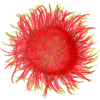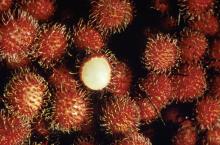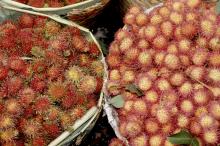Maturity and Quality
Rambutan fruits are borne in clusters; each fruit has seeds surrounded by an aril (edible portion) which is covered by the pericarp and its hairs or soft spines or spinterns (1-1.5 cm long). Attainment of red color is the main harvest index. A minimum soluble solids content of 16% may also be used; cultivars vary in their maximum soluble solids content from 17 to 21%.
- Size, uniform reddish, color, freedom from defects and decay
- Sweetness is related to sugar content (average is 10% sucrose + 3% fructose + 3% glucose = 16% total)
- Low acidity (average is 0.36%, mainly citric acid)
- Good source of Vitamin C (average is 70mg/100g edible portion)
- Browning, which detracts from visual quality, is directly associated with water loss and physical damage
Postharvest Handling and Storage
10-12°C (50-54°F) depending on cultivar (cultivars vary in their chilling sensitivity)
Storage potential = 12-14 days.
20-60ml CO2/kg·hr at 25°C (77°F); non-climacteric respiratory pattern.
To calculate heat production multiply ml CO2/kg·hr by 440 to get Btu/ton/day or by 122 to get kcal/metric ton/day.
Rambutans are picked ripe and do not benefit from ethylene treatment or ethylene scrubbing during their postharvest handling.
90-95%; maintenance of high RH is essential to minimizing water loss and preventing skin darkening (browning).
0.1 to 0.7 µl/kg·hr at 25°C (77°F)
An atmosphere of 3-5% O2 and 7-12% CO2 reduces respiration rate and retards red color loss and other symptoms of senescence. Postharvest-life potential in CA is 4 weeks (vs. 2 weeks in air).
Disorders
Chilling Injury. Symptoms include dark-maroon coloration in some cultivars and bronzing in other cultivars of the skin and spinterns. The minimum temperature - time combination that induces chilling injury varies among cultivars from 5°C (41°F) for >7 days to 7°C (45°F) for >14 days.
Skin Splitting. Skin splitting of thin-skinned cultivars occurs after heavy rains or sudden uptake of water by the fruit during the latter stages of development.
- In most cases, postharvest-life of rambutans is terminated because of severe browning and other discoloration (resulting from physical damage, water loss, and/or chilling injury) rather than pathological disorders
- Gliocephalotrichum bulbilium is a major cause of pre- and post-harvest rot. Infection is primarily through injuries including cut stem ends. Symptoms begin as light-brown, water-soaked areas in the rind and pulp which enlarge and become dark-brown to black
- Stem-end rot, caused by Botryodiplodia theobromae, may affect rambutans in some production areas
- Control strategies include effective preharvest disease control, careful handling to minimize physical damage, proper sanitation, and good temperature and humidity management





